Bulletin – March 2015 Global Economy Australia and the Global LNG Market
- Download the article 368KB
Abstract
Australian exports of liquefied natural gas (LNG) will rise significantly over the next few years as a number of large-scale investment projects reach completion. The bulk of these exports will be to Asian customers under long-term contracts, with their price linked to the price of oil. The Asia-Pacific LNG market over the next decade will be influenced by potential changes to the composition of Asian energy demand, the magnitude of the increase of US LNG exports to Asia and any changes to the traditional oil-based pricing mechanism. The ramp-up in LNG production will boost Australian output and incomes over the next few years; however, the effect on Australia's living standards will be lessened to some extent by the high level of foreign ownership and the relatively low labour intensity of LNG production.
Introduction
Australian exports of liquefied natural gas (LNG) are expected to pick up substantially as a number of large-scale LNG projects begin production over the next few years. This follows investment of approximately $200 billion – equivalent to around 12 per cent of annual Australian GDP – which was largely in response to increased Asian demand for LNG. In value terms, LNG is expected to become Australia's second largest commodity export (after iron ore) by 2018, with the bulk of these exports destined for Asian markets. This article provides an overview of the global market for natural gas and details the oil-linked pricing of Australian LNG exports.[1] It also discusses factors that are likely to influence the LNG market in the Asia-Pacific region over the period ahead, as well as the channels through which developments in the Australian LNG sector affect the domestic economy.
Global Natural Gas Trends
Natural gas is a low carbon-emitting fossil fuel primarily used for power generation, as well as a wide range of other industrial, commercial and residential uses. It reaches the end user either directly in its gaseous form through pipelines or via the production of LNG. The latter involves processing and cooling the natural gas into its liquid form (in a liquefaction facility through modules known as ‘trains’) for transportation. At the destination, LNG is either stored or converted back into natural gas at regasification plants and then delivered to the end user by pipeline.
Consumption of natural gas has increased gradually to account for around one-quarter of global primary energy consumption (Graph 1). North America and Europe are the largest consumers of natural gas, delivered via vast pipeline networks. However, natural gas consumption has gradually become more widespread, increasing markedly in the Middle East and Asian regions. While natural gas still comprises a relatively small share of Asia's total energy mix, it has increased in importance due to a number of factors including greater emphasis on lowering air pollution and carbon emissions through use of cleaner burning fossil fuels. Within the Asian region, China has recently overtaken Japan as the largest consumer of natural gas, with consumption increasing almost fourfold in the past decade.
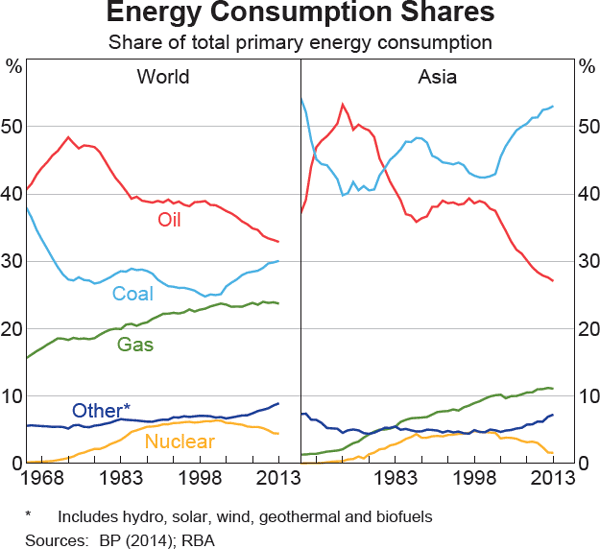
Localised sources of production accounted for around 70 per cent of global natural gas consumption in 2013 (Graph 2). In North America, natural gas production has benefited from new extraction methods, including horizontal drilling and hydraulic fracturing, which have driven rapid growth in US unconventional production of crude oil and natural gas (see below). In Asia, many areas are geographically removed from substantial natural gas reservoirs, making it expensive or impractical to transport natural gas by pipeline. LNG has proven to be a viable alternative for Asian consumers, which represent 75 per cent of global LNG demand; overall, LNG currently accounts for around 10 per cent of global natural gas consumption.
While LNG only accounted for 5 per cent of Asia's total energy consumption in 2013, this is expected to rise as the supply of LNG increases markedly over the next few years. Trends in consumption (and production) tend to change slowly given the costly and large-scale investments in infrastructure required for both liquefaction at the source and regasification at the destination. Japan is the largest global importer of LNG and demand for natural gas has increased since the Fukushima nuclear disaster in March 2011, as utilities have used gas-fired power generation to replace the country's idled nuclear power capacity (Graph 3). Other major importers such as Korea, India and Taiwan also rely primarily on LNG to satisfy domestic demand for natural gas. China's LNG imports supplement its sizeable domestic gas reserves and natural gas imports supplied via pipelines.
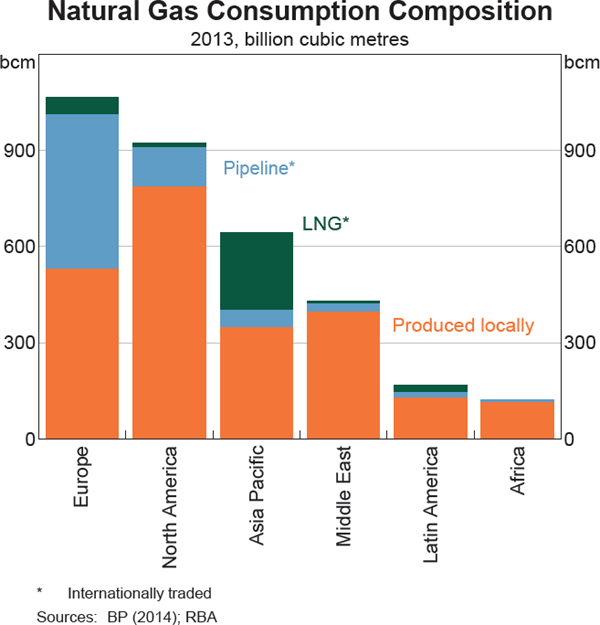
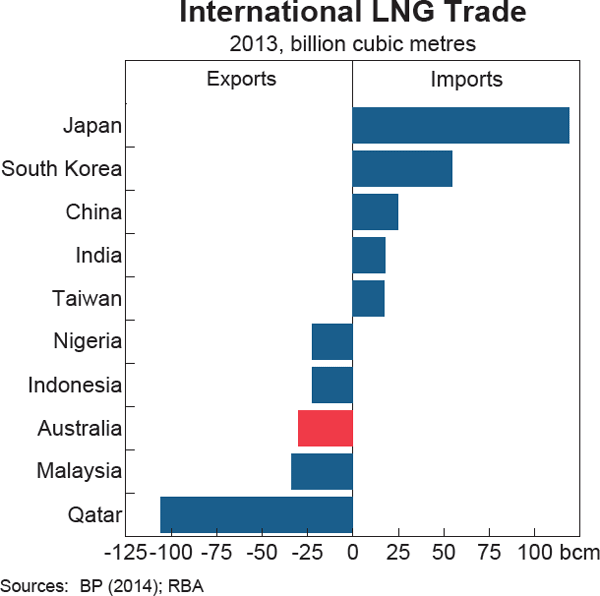
In response to increased demand for natural gas, global liquefaction capacity has risen since the early 2000s. Qatar is currently the largest exporter of LNG, producing around one-third of the LNG traded, following a substantial increase in liquefaction capacity between 2004 and 2011.
In 2013, Australia was the third largest exporter of LNG, producing a little less than 10 per cent of global LNG exports. However, if the global liquefaction capacity currently under construction or committed proceeds as planned, Australia is expected to become the largest global producer of LNG by 2018 at a total nameplate (theoretical maximum) capacity of around 85 million tonnes per annum (mtpa). The ramp-up of exports is expected to occur largely between 2015 and 2017 (Graph 4). A total of eight new Australian liquefaction projects received final investment approval between 2007 and 2012; two have begun production while the remaining projects are under construction.[2] These comprise large-scale conventional LNG projects in Western Australia and the Northern Territory, including the world's first floating LNG vessel to be located offshore in the Western Australian Browse Basin.[3] In addition, three unconventional coal seam gas (CSG) projects are under construction in Queensland, one of which has commenced production.[4]
Most of Australia's current LNG production is exported to Asia; more than 80 per cent is exported to Japan, while China and Korea account for much of the remaining share (Graph 5). The LNG from Australian projects under construction is also committed to Asian purchasers under long-term contracts, albeit with more diversification in the destination of these exports. However, some projects under construction have volumes that are not yet under contract, as well as volumes assigned to the producer's own portfolio (‘portfolio LNG’); the ultimate destinations for these LNG cargoes are uncertain.[5] Nonetheless, our current estimates (under the assumption that the production ramp-up for projects proceeds as publicly indicated) suggest that China will purchase around 20 per cent of Australian LNG exports under contract by 2020, while the share of exports to Japan under contract will fall to around 45 per cent. The share of exports to other regional trading partners will also rise, with small increases in exports to Malaysia, India and Taiwan.
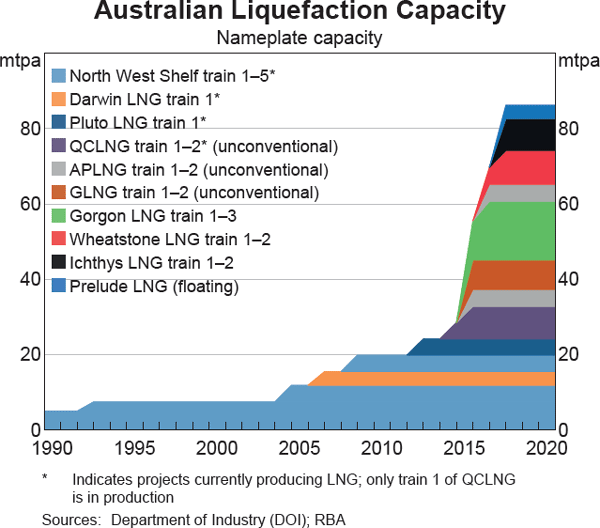
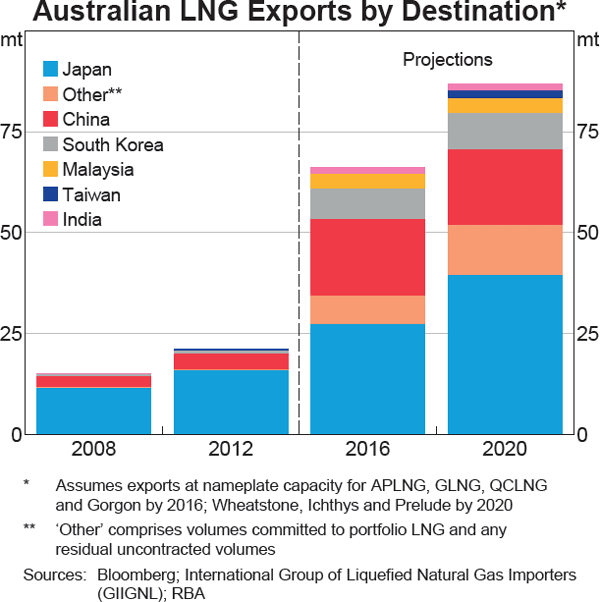
Asia-Pacific LNG Market Structure and Pricing
As noted in Jacobs (2011), the natural gas market is globally segmented. As there are differences between market structure and pricing conventions in the Atlantic (covering North America and Europe) and the Asia-Pacific regions, there can often be significant differences in the price of natural gas around the world. The current pricing of Australian LNG exports is based on conventions in the Asian LNG market, which involve long-term contracts linked to the price of oil. The historical reason for this was because Japan began importing LNG in 1969 to diversify its energy supply. Crude oil was the major competing source of fuel for generating power at the time, providing a basis for oil-linked LNG pricing (Rogers and Stern 2014). As other Asian economies began importing LNG, long-term oil-linked contracts were already well established, which provided the basis for the LNG pricing that prevails in the Asia-Pacific region. This contrasts with the more developed spot market pricing of natural gas in North America, and to a lesser extent Europe, where competing sources of gas (pipeline and LNG) are priced in ‘hubs’, which also act as the pricing and delivery points for natural gas futures contracts. These hubs reflect the interaction of multiple sources of natural gas supply and demand, either physically via pipeline networks (such as the US Henry Hub) or notionally (such as the UK's National Balancing Point, which is a ‘virtual’ hub rather than a physical location).
Asian LNG purchasing agreements tend to be long term in nature, typically in the order of 15 to 20 years. This affords producers a degree of certainty over the recovery of the substantial upfront expenditure required for LNG investments. LNG customers have often contributed to the funding of major projects, which have tended to be accompanied by long-term LNG purchasing agreements and align the interests of producers and customers. The security of energy supply under long-term contracts is also important for many Asian importers.
The link between LNG and oil prices in Asian LNG contracts is negotiated confidentially between producers and customers. However, contracts are typically linked to the price of Japanese customs-cleared crude oil (JCC), which reflects the average price of crude oil imported into Japan and in turn is highly correlated with the lagged price of Brent oil (Graph 6). While the benchmark relates to Japanese crude oil imports, it has also been adopted for LNG pricing by other Asian importers. LNG prices are denominated in US dollars per million British thermal units (US$/mmBtu), which is a measure of the price per unit of energy content.
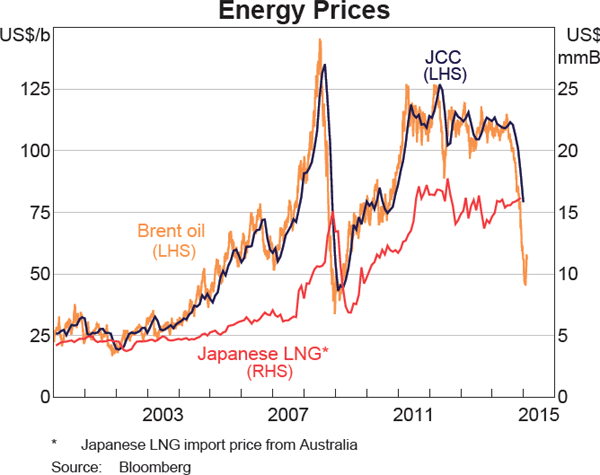
In generic terms, the formula linking the price of LNG to JCC can be approximated by the following:

where PriceLNG is the long-term delivered contract price of Asian LNG (measured in US$/mmBtu) and PriceJCC is the JCC price of oil (measured in US$/barrel), often measured as a lagged average of the Brent oil price. β is typically referred to as the pricing slope, which determines the sensitivity of LNG prices to changes in the oil price benchmark (factoring in the conversion between US$/barrel and US$/mmBtu). The Australian LNG pricing slope reportedly ranges between 12 and 15 per cent. α reflects transportation costs, and typically ranges between US$0.5 to US$1/mmBtu for Australian LNG.
Since the 1990s, contracts have become more flexible and incorporate additional features to address pricing risk. Some newer contracts have flexibility on fixed destination clauses and take-or-pay commitments, and a greater share of sales contracts are under more flexible free on board (FOB) agreements.[6] Long-term contract price arrangements can often be subject to periodic renegotiation (e.g. every three to five years). Renegotiations may occur due to bilateral agreement or can be triggered contractually by large oil price movements. Some contracts also include a non-linear pricing slope, referred to as an ‘s-curve’. With an s-curve agreement, the sensitivity of LNG prices to oil price movements varies, protecting producers' earnings at low levels of oil prices and limiting the impact on purchasers' energy costs when oil prices are high (Graph 7). Empirically, the s-curve ‘kinks’ appear to occur at oil prices below around US$40–60/barrel and above US$90–110/barrel.[7]
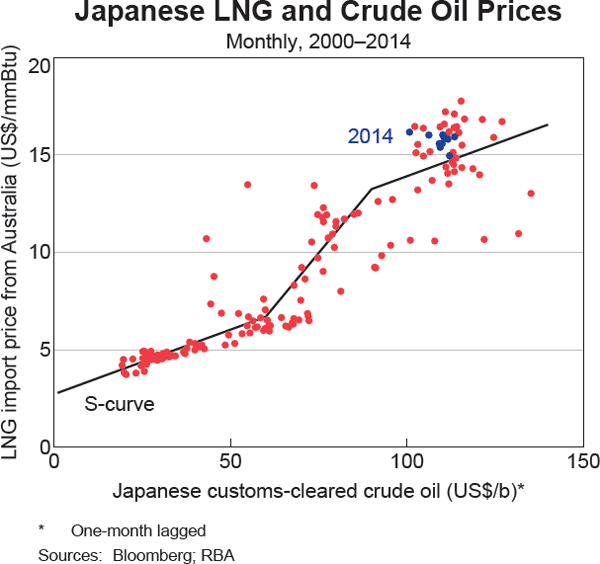
There has also been an increase in shorter-term LNG trade (i.e. spot and contract sales of terms between one and four years). At present, short-term purchases account for 25–30 per cent of global LNG trade, compared with less than 5 per cent before the mid 2000s (IEA 2013) (Graph 8). This reflects a number of factors, including increased flexibility in some contracts facilitating short-term sales, an increase in Japanese demand following the Fukushima disaster, and less concentration of sources of supply and demand for LNG.
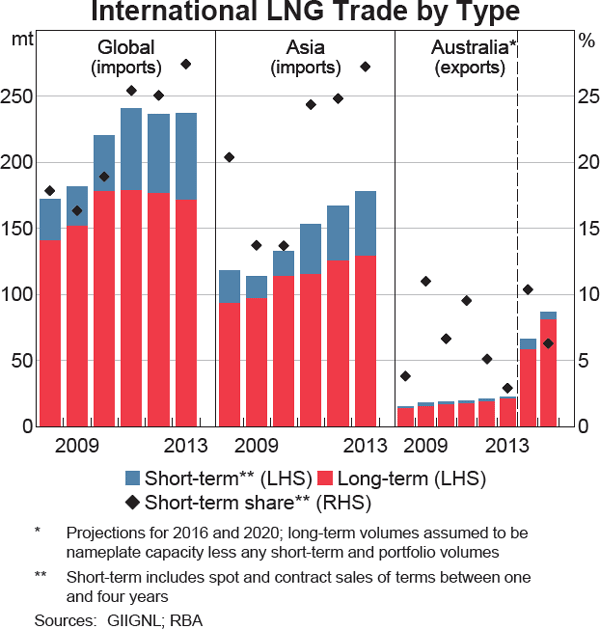
Of Australia's current LNG production, only around 5–10 per cent is estimated to be sold on a short-term basis. The share of shorter-term pricing is not expected to change significantly over the next few years. This is mainly because producers have to recover significant costs associated with developing greenfield projects (including both upstream drilling and processing, and downstream liquefaction and port facilities) and many Australian LNG projects under construction were, in part, financed by customers who wanted to secure their LNG supply.
However, as the share of short-term LNG trade has increased in Asia, spot LNG prices have become a more relevant indicator of market conditions, leading to the creation of several spot ‘markers’ for Asian LNG and a nascent derivatives market. Asian spot and import LNG prices have traded at a premium to international gas prices since 2008, particularly US Henry Hub gas, although this has become significantly less pronounced more recently (Graph 9). The LNG spot price has fallen sharply over the past year, largely reflecting the impact of the sharp decline in oil prices. The average price of Australian exports to Japan remains significantly higher than the spot price due to the lagged structure of long-term Japanese contracts but can be expected to decline over the first half of 2015 in response to the lower oil price.
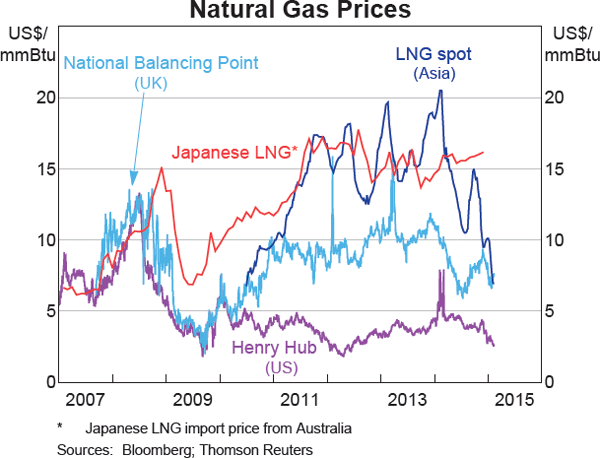
Factors Influencing the Future of Asia-Pacific LNG Markets
There are a number of factors that are likely to affect the dynamics of the Asia-Pacific LNG market in the medium term. US LNG supply is expected to increase considerably as technological advancements and a period of high energy prices have led to a dramatic increase in assessments of recoverable resources of natural gas and oil from unconventional sources.[8] This has spurred a rapid surge in unconventional natural gas and oil production, which is expected to result in US natural gas production exceeding domestic consumption by 2017 (Graph 10).
Since the scale of natural gas reserves became apparent, US producers have commenced construction of four projects with planned nameplate liquefaction capacity of around 50 mtpa, which are expected to gradually ramp up production between 2016 and 2020 (compared with Australia's expected nameplate capacity of around 85 mtpa by 2018).[9] Long-term agreements from US LNG projects with Asian customers for 40 mtpa of LNG have been announced to date. Around 20 mtpa of this is under tolling agreements, which commit customers to paying a fee for reserving liquefaction capacity (rather than necessarily purchasing LNG), with additional liquefaction fees only charged for LNG volumes processed. Some of these agreements between Asian buyers and US producers are reportedly linked to the price of US natural gas (at around 115 per cent of the Henry Hub price plus a liquefaction fee of around US$3/mmBtu). Shipping costs from the US east coast to Asia are expected to be between US$2/mmBtu and US$3/mmBtu (compared with shipping costs from Australia to Asia of around US$1/mmBtu).

The rise in US natural gas and oil supply has a number of implications for the Asia-Pacific LNG market. Oil prices (and hence LNG prices) have declined sharply over the past year, and additional supply from US unconventional production has been cited as a key factor. Additionally, these developments mean that the United States could potentially become the world's largest LNG exporter, adding considerably to market supply. Moreover, US exports of LNG based on Henry Hub pricing could substantially reduce the costs of LNG for Asian importers and diversify their energy mix, while providing flexibility for customers (via tolling agreements). Offsetting this, shipping costs from the east coast of the United States to Asia will be higher than Australian shipping costs and the cost of new US liquefaction capacity could be greater in the future.
The significant new LNG supply coming on line over the next decade reflects not only technological advancement but also a response to burgeoning demand for gas, particularly from Asia. Energy agencies project that global natural gas demand will increase by almost 15 per cent by the end of 2020, with China's demand almost doubling over that period (EIA 2013; IEA 2014) (Graph 11). The actual and projected increase in Asian demand, particularly from China, reflects government policies designed to reduce reliance on thermal coal for electricity generation and lower carbon emissions. However, the outlook for LNG demand in Asia will depend on the availability and price of competing energy sources (including renewable energy), and the extent to which Asia's natural gas demand translates into demand for LNG (rather than pipeline imports or locally produced gas).
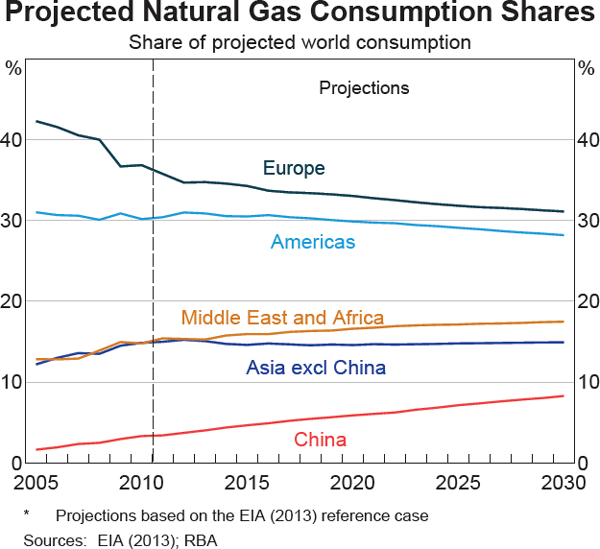
Alternatives to Asian oil-linked pricing arrangements have the potential to influence the future of the Asia-Pacific LNG market. A period of elevated LNG prices relative to international natural gas prices had prompted some Asian LNG customers to raise the prospect of shifting away from oil-linked pricing and towards other mechanisms that might better reflect fundamental forces of supply and demand for LNG, leading to a range of pricing proposals.[10] These include contracts based on the Henry Hub natural gas price, which is gaining some traction due to the prospect of significant US LNG exports by the end of the decade. However, Henry Hub-based LNG pricing is not guaranteed to result in lower energy prices than oil-linked contracts, particularly given the liquefaction and transportation costs involved. Contracts based on the Asian spot price of LNG have also been advocated.
The confluence of new sources of LNG supply, the evolution of demand and alternative pricing arrangements are expected to have the greatest influence on future Australian LNG projects, given most existing (and forthcoming) production is committed under long-term oil-linked contracts. However, the factors outlined above could also affect pricing and volumes of Australia's uncommitted short-term production capacity. As such, the impact on the domestic economy of Australia's increasing LNG production will be determined by the arrangements pertaining to existing projects, which will remain relevant for the foreseeable future given the long-term nature of LNG projects.
Channels through which LNG Production Affects the Australian Economy
The decline in LNG investment and ramp-up in LNG production and exports is expected to affect Australian economic output (real GDP) and national income in a number of ways.[11] LNG investment contributed an estimated ¼ percentage point on average to Australian annual GDP growth between 2008 and 2013, once the high share of imported inputs used to construct these projects is taken into consideration. The peak in LNG investment was in late 2013, and the continued falls in LNG-related investment will subtract from GDP growth in the next few years as the construction of large-scale projects is gradually completed. As the projects begin to ramp up production, the Bank currently estimates that LNG exports will contribute around ¾ percentage point to GDP growth in 2016/17. The timing of the boost will depend on whether these projects are completed on schedule and how quickly production is ramped up. As production of LNG gradually stabilises at a higher level, the boost to GDP growth will dissipate although GDP will remain at a higher level.
LNG is expected to become Australia's second largest commodity export in value terms after iron ore by 2018. This means that LNG will have an increasingly important bearing on Australia's terms of trade over the next few years. As Australia's LNG export prices are tied to oil prices, fluctuations in the global price of oil will have an important effect on the terms of trade (see ‘Box A: Oil Price Scenarios and LNG Export Prices’). While changes in the terms of trade do not directly affect real GDP, they will affect the purchasing power of domestic income. This effect is commonly measured by comparing the change in real GDP with the change in real gross domestic income (real GDI), which deflates nominal exports by import prices rather than export prices (RBA 2015). However, in the event that LNG prices boost the terms of trade (e.g. if oil prices were to increase over the next few years), the real GDI measure will overstate the increase in purchasing power of national income as some of the benefit from the rise in terms of trade will accrue to foreign investors (e.g. through dividend payments to non-resident owners of LNG companies operating in Australia), and as a greater share of gross income will be used to offset depreciation of the LNG capital stock as it increases in size. Real net national disposable income (real NNDI) attempts to adjust real GDI for these effects. While it is difficult to gauge the share of foreign ownership of the LNG industry, it is estimated to be substantial. This suggests that a sizeable portion of profits will flow to foreign investors.
With this in mind, the rise in LNG export receipts is expected to affect the domestic economy in a number of different ways. Household incomes are boosted for those employed in either the LNG investment or production phase. However, liaison and company reports suggest that the production phase of LNG is highly capital intensive and will not require as much labour as the investment phase. Household incomes will also be supported via the domestic share of the profits of LNG companies. To the extent that the increase in government revenues (discussed below) are passed on to households via transfer payments or changes to taxes, this will also support household incomes. The effect of changes to domestic gas prices resulting from increased LNG production for export markets will offset some of these factors on real household incomes.
Box A: Oil Price Scenarios and LNG Export Prices[*]
The price of Australia's current and future LNG production is linked to the price of crude oil, so fluctuations in the oil price will affect the terms of trade (and hence Australian living standards). This box explores the sensitivity of Australian LNG export prices to fluctuations in oil prices under three scenarios: a ‘reference case’ which assumes that Brent oil prices follow futures prices as at February 2015 (i.e. oil prices move higher to US$80 per barrel by the end of 2020); a ‘low case’ where oil prices fall to US$40 per barrel; and a ‘high case’ which assumes oil prices increase to US$100 per barrel.[a1]
Under the reference case, Asian LNG prices under long-term contracts are estimated to fall to a low of US$8/mmBtu by mid 2015 (in lagged response to the sharp fall in oil prices seen to date), before increasing to US$11/mmBtu at the end of the scenario horizon (Graph A1).[a2] This is considerably lower than the price observed in recent years (reflecting the sharp fall in oil prices over the past year) but above the price of US$6.5/mmBtu under the low case.
Using the historical relationship observed between oil prices and Australian gas export prices, the natural gas implicit price deflator in the reference case is assumed to fall sharply in 2015 before gradually returning to its earlier level (Graph A2). This reflects the recovery in Brent oil prices implicit in the futures curve.
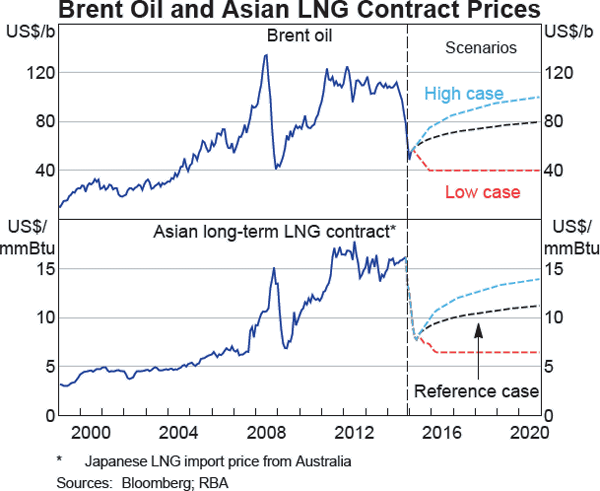
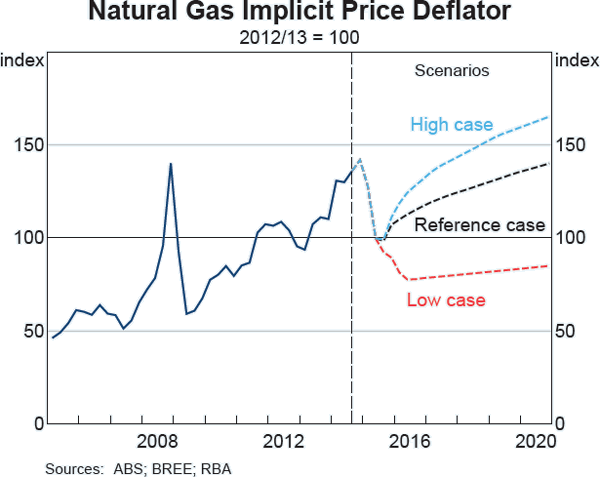
The terms of trade reach a trough in mid 2015 under the reference scenario, largely reflecting the impact of lower bulk commodity prices (Graph A3). As Australia is a net oil importer, the terms of trade are boosted by lower oil prices in the near-term. This is expected to be offset to some extent by lower LNG prices; this effect is small in the near term but is expected to grow as LNG exports increase in importance. The terms of trade under the low scenario are 3 percentage points lower than the reference case by the end of 2020, which reflects the US$40 per barrel difference between the two scenario oil price assumptions in 2020.
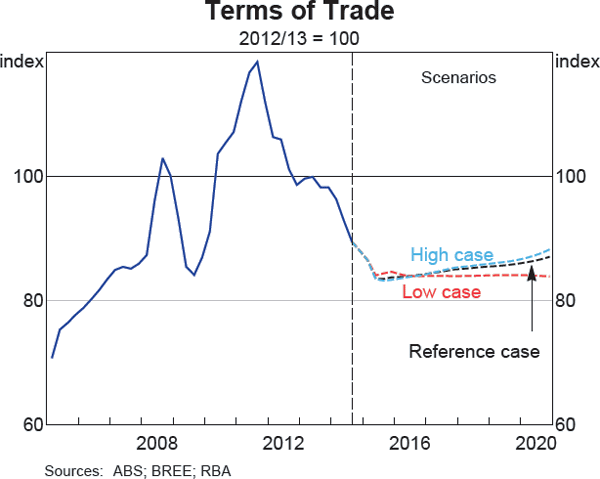
Government revenues are also expected to rise as LNG production increases. Federal government revenue will increase via corporate tax income and the petroleum resource rent tax, while some state and territory governments will receive higher royalties. The magnitude of the increase to revenues will depend on the prevailing oil price and royalties arrangements between state and territory governments and LNG producers, and the extent to which tax payments will be reduced by deductions (which are assumed to be fairly large in at least the first few years of production).
Conclusion
By 2018, Australia is expected to become the world's largest exporter of LNG. The bulk of these exports have been purchased by Asian importers under long-term contracts, and the price of these is linked to the oil price. There are a number of factors that are likely to influence the Asia-Pacific LNG market over the next decade, including the emergence of the United States as a key supplier of LNG and the gradual change in the scale and composition of energy demand in Asia. Australian production of LNG is expected to ramp up substantially over the next few years, providing a significant contribution to domestic output. The effect on Australian living standards will be less noticeable than this given the low employment intensity of LNG production, the high level of foreign ownership of the LNG industry and, in the near term, the use of deductions on taxation payments.
Footnotes
The authors are from Economic Analysis Department. [*]
See Jacobs (2011) for additional background on the global market for LNG and an earlier overview of the Australian LNG industry. [1]
Australian projects which are currently producing LNG include the North West Shelf (NWS) and Pluto LNG in Western Australia; Darwin LNG in the Northern Territory; and Queensland Curtis LNG (QCLNG) train 1 in Queensland. Projects currently under construction include Gorgon, Wheatstone and Prelude Floating LNG in Western Australia; Ichthys in the Northern Territory; and Australia Pacific LNG (APLNG), Gladstone LNG (GLNG) and QCLNG train 2 in Queensland. There are a number of additional Australian LNG projects that have been proposed or are at the feasibility stage, without yet being committed (Department of Industry 2014). [2]
Floating LNG involves the use of a specially designed vessel to produce, liquefy, store and transfer LNG from offshore. [3]
Unconventional LNG refers to production from resources such as tight geological formations, including shale and coal seams (CSG). CSG accumulates in layers along the surfaces of coal deposits, kept in place under water and ground pressure. CSG production involves drilling wells, including horizontal wells if the geology is suitable, and stimulating the coal bed to release pressure within the production zone, allowing natural gas to be extracted. [4]
Portfolio LNG is marketed by major energy companies from multiple, potentially geographically diverse projects in which the company has an interest. In practice, this might involve consigning part or all of an LNG project's liquefaction capacity to their internal portfolio, which is onsold to customers under long-term contracts. In some instances, an LNG project will assign a share of production to the portfolio and the remainder falls under traditional long-term agreements, often to equity partners in the project. A number of the conventional and unconventional Australian projects reportedly have volumes assigned to producers' portfolios. [5]
A fixed destination clause restricts the importer from diverting or onselling any surplus LNG cargoes. FOB contracts shift the risk of transportation from the producer to the purchaser, who is responsible for transportation and associated costs. This contrasts with the other main form of sales agreement, where the purchase price includes costs, insurance and freight. This typically makes the seller responsible for transportation and is referred to as ‘delivered ex-ship’. [6]
The s-curve in Graph 7 is estimated with a constrained regression, which specifies inflexion points at US$60 and US$90 per barrel, and restricts the slope of the curve to be identical above and below US$60 and US$90 per barrel, respectively. [7]
Unconventional oil and gas refers to resources which are generally produced from more tightly formed geological systems, requiring advanced technologies and extraction methods, including horizontal drilling and hydraulic fracturing. This contrasts with conventional production which involves traditional drilling techniques. Unconventional gas is extracted from coal seams (CSG), shale rock and other tightly formed geological areas (dispersed within silts or sands). Unconventional oil production, often referred to as tight oil, is extracted from shale rock, sandstone and carbonate. [8]
Currently, 30 mtpa of additional US liquefaction capacity appears likely to proceed and considerably more is under regulatory review. Agreements with customers for prospective capacity are typically a prerequisite for the project receiving final approval. [9]
For a detailed discussion of alternative pricing structures in the Asia Pacific, see IEA (2013); Rogers and Stern (2014). [10]
This discussion assumes that all production is destined for the export market and also does not explore the likely effects this LNG production will have on domestic gas prices and its subsequent impact on output. [11]
Footnotes Box A
The authors would like to thank Trent Saunders for his valuable technical assistance in this analysis. [*]
LNG export volumes are assumed to follow BREE's (2014) long-run projections until 2018/19 and are constant thereafter. For all other variables, RBA estimates taken at the time of the February 2015 Statement on Monetary Policy are used until the June quarter of 2017 and are assumed to be unchanged thereafter. [a1]
The Asian long-term LNG contract price used in this analysis assumes a price slope of 13.5 per cent and a constant of US$0.5/mmBtu. The contract price is assumed to follow a one month lag of the Japanese Customs-cleared Crude oil price, which is proxied by the 3-month average of the Brent oil price, one month lagged. [a2]
References
BP (2014), BP Statistical Review of World Energy, June 2014, BP plc, London.
BREE (Bureau of Resources and Energy Economics) (2014), Resources and Energy Quarterly, September Quarter 2014.
Department of Industry (2014), ‘Gas Market Report’, November.
EIA (Energy Information Administration) (2013), International Energy Outlook 2013, US Department of Energy, Washington, DC.
EIA (2014), Annual Energy Outlook 2014: With Projections to 2040, US Department of Energy, Washington, DC.
IEA (International Energy Agency) (2013), ‘Developing a Natural Gas Trading Hub in Asia’.
IEA (2014), Medium-term Gas Market Report 2014, OECD/IEA, Paris.
Jacobs D (2011), ‘The Global Market for Liquefied Natural Gas’, Bulletin, September, pp 17–27.
RBA (Reserve Bank of Australia) (2015), ‘Box A: The Effects of Changes in Iron Ore Prices’, Statement on Monetary Policy, February, pp 13–15.
Rogers HV and J Stern (2014), ‘Challenges to JCC Pricing in Asian LNG Markets’, The Oxford Institute for Energy Studies, OIES Paper NG81.